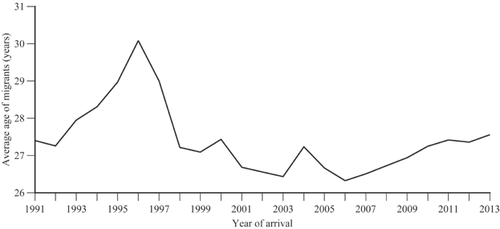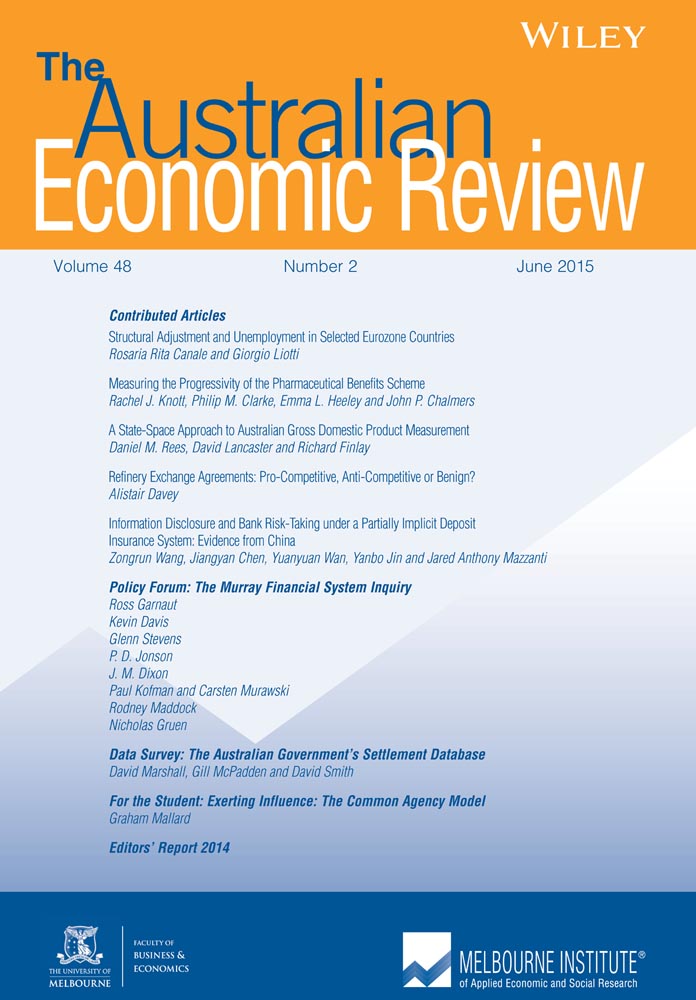The Australian Government's Settlement Database
Abstract
The Australian Government's Settlement Database contains over 3 million records of permanent migrants to Australia. Records in the Settlement Database extend back to 1991 and are compiled from a number of different visa-processing and movement-recording systems. This article provides an overview of the Settlement Database, including a summary of the data fields, actual and potential uses for the data, recognised limitations of the dataset and details on how to access the data.
1 Introduction
The Settlement Database (SDB) is an Australian Government database which currently contains over 3 million records of permanent migrants to Australia. The SDB was developed to provide statistical data for government and community agencies involved in the planning and provision of settlement services. The SDB is built from a range of different data sources, most of which are currently managed by the Department of Immigration and Border Protection (DIBP). While the administration of the SDB was, until recently, also a DIBP responsibility, following the change of government in 2013, functional responsibility was moved to the Department of Social Services (DSS).
The Australian Bureau of Statistics (ABS) has identified the SDB as an Essential Statistical Asset (ABS 2013). This initiative, endorsed by the Australian Statistics Advisory Council in November 2010, compiled a list of agreed essential statistical assets that require effective prioritisation of investment, focus and effort within the National Statistical Service and that are critical to decision-making in a complex and sometimes fragmented information environment across Australia.
At present, the easiest means by which to extract data from the SDB is through the Settlement Reporting Facility (SRF). The SRF is a publicly available web-based interface that accesses a limited range of information from the SDB (visa details, geography, demographics) and allows the production of statistical reports of settler data. Reports can be run by specific criteria and narrowed down through the use of filters. The limited range of variables is to ensure confidentiality of the migrants in the database. The SRF is available on the DSS website,1 while more detailed data sourced directly from the SDB can be supplied by DSS on request.2
This article provides an overview of the SDB and its characteristics, limitations of the dataset and some examples of its uses.
2 Data Fields
- visa granted on or after 1 January 1991 and arrived in Australia within 25 months of visa grant (or are yet to arrive and it has been less than 25 months since their visa was granted); or
- arrived in Australia on or after 1 January 1991, having been granted a permanent (or provisional) visa prior to then.
In addition, some data from the Adult Migrant English Program (Department of Industry) and from Medicare Australia (Department of Human Services) are also appended to the DIBP-sourced information. Data are refreshed on the SDB on the fourth of each month and loaded to the SRF on the fifth of each month.
The SDB therefore contains a wide range of administrative information covering issues from before, during and after migration to Australia. Table 1 provides an overview of this information, while a full list of all data items available on the SDB and information on these items can be found in the SDB Data Dictionary.3
| Theme | Variable |
|---|---|
| Personal characteristics | Age; gender; country of birth; main language spoken; marital status; education; ethnicity; religion; citizenship; English proficiency |
| Migration details | Arrival stream; applicant status (principal/secondary); visa sub-class; grant date; arrival date; arrival age |
| Postarrival details | Residence (including state, statistical division, statistical sub-division, statistical local area, local government area);a Australian citizenship |
Note
- (a) Australian Statistical Geography Standard indices (SA2, SA3 and SA4) will be implemented in due course.
In its basic form, the SDB therefore provides a crucial record of all migrants settling in Australia since 1991, as well as a variety of their characteristics. Such data provide a valuable resource for researchers and policy-makers with an interest in Australia's population dynamics and the implications of migration over time. It also provides a valuable tool for service providers in helping to inform the delivery of services and programs for migrants.
For example, in Figure 1, data from the SDB show the changes in numbers of migrants arriving through the Family, Humanitarian and Skill streams since the SDB was established. During the first 10 years, no clear trends are evident, with each of the three streams fluctuating in terms of numbers and relative strength when compared to the other streams.

Since about 2000, however, it is very clear that the Skill stream has grown to become the dominant migration pathway for persons settling in Australia. In contrast, numbers in the Family pathway increased only slowly during the early 2000s before rising more substantially during the past decade. Numbers arriving through the Humanitarian pathway have, in contrast, been relatively stable throughout the entire period, aside from a spike in 1994 and 1995.
These changes have had a modest effect on the demographics of the migrant cohort. In Figure 2, the average age of migrants peaked at around 30 years in the mid-1990s—a period when close to 70 per cent of all Migration Programme visas were in the Family stream and more than one in 10 were in the parent category. With the increased emphasis on skilled migration from 1996–1997 onwards, the average age of migrants has fallen by around 3 years. This is because Skill Stream migrants tend to be younger due to age eligibility requirements and the parent category now accounts for only about 5 per cent of visas issued.

3 Other Uses
In addition to preparing statistical reports and analyses such as those presented here, the data held in the SDB also have the potential for other uses. One such use is to draw participants for surveys of migrants to Australia. At present, there are two key surveys underway which have identified suitable participants from information held in the SDB: the Continuous Survey of Australian Migrants4 and The Building a New Life in Australia Longitudinal Study of Humanitarian Migrants.5 Despite both studies having strict protocols guiding who was eligible to participate in each study (for example, specific visa sub-classes, arrival dates and age groups), it was possible to filter the SDB to ensure that only eligible participants were included in the sampling frame. This ensures that time and resources are not wasted by contacting migrants who are not eligible, as would occur if a randomised approach was undertaken.
Value-adding to the SDB through the linking of other datasets has also been recognised as a valuable use of the resource. To date, the highest profile data-linkage work has been done by the ABS and its Census Data Enhancement project. This work involved linking the SDB to the 2011 Australian Census dataset to produce the publicly available Australian Census and Migrants Integrated Dataset (ACMID). More detailed information about ACMID, including its background, linking methodology and file structure, is available on the ABS website (ABS 2014a).
With the linked ACMID dataset, it is possible to conduct detailed analysis on a wide range of issues, which was not possible with either the Census or SDB datasets in isolation. Recognising the value of this, Smith and Smith (2014) conducted a brief analysis of education, employment and English language issues for recent Australian migrants, demarcated by a variety of SDB variables. They were able to identify clear differences between how different groups of migrants fare over time, which was not possible previously.
Other avenues for linking data to the SDB have also been explored. For example, the ABS recently undertook a project to assess the feasibility of linking records from the SDB to personal income tax data held by the Australian Taxation Office. The study concluded that linking was feasible, provided name and address information could be used as linking variables, and that it has the potential to be a valuable source of data not available elsewhere, such as the economic contribution of migrants to Australia (ABS 2014b).
Another such example is Jensen's (2014) discussion of the effects of migration on innovation. He proposes that the SDB could provide the backbone for further research by linking it to innovation-related data, such as that held by IP Australia or the Australian Securities and Investments Commission. Such an exercise would involve linking SDB records to the names of persons registering patents or those starting businesses in order to generate a better measure of how migration can influence innovation and entrepreneurship outcomes.
4 Data Limitations
- data have not been adjusted to reflect settlers who are deceased;
- data have not been adjusted to reflect settlers who have permanently departed Australia;
- data have not been adjusted to reflect settlers who have had their visas cancelled;
- includes some duplicate settler records;
- includes only the settler's latest known residential (or intended residential) address, as address information is only updated if the department is notified, and some settlers have no address details recorded;
- location data are based on the 2011 Australian Standard Geographical Classification; and
- includes only the latest permanent (or provisional) visa for a settler.
With respect to reporting of data for smaller geographical areas, a level of inaccuracy should be assumed due to the difficulty in sourcing up-to-date address information. This is because although the SDB is updated monthly with new address details sourced from Medicare, such updates are dependent upon the migrant both engaging with Medicare and supplying new details.
Additionally, some of the fields are based upon self-reports (for example, main language or religion) or self-assessments (for example, English language proficiency) during the visa application process. Such data must therefore be interpreted accordingly, particularly if attempting to compare with other data sources. Some information is provided on a voluntary basis (such as religion and language proficiency). If the information requested is not provided, reports may list items as ‘Unknown’ or ‘Not stated’. Table 2 highlights completeness rates for selected data fields.
| Data field | Completion rate (all streams) | Humanitarian stream | Family stream | Skill stream |
|---|---|---|---|---|
| Country of birth | 100 | – | – | – |
| State of residence | 98 | 98 | 99 | 98 |
| Gender | 100 | – | – | – |
| Postcode | 90 | 97 | 93 | 88 |
| Ethnicitya | – | 77 | 42 | 0.6 |
| English proficiency | 60 | 71 | 62 | 56 |
| Main language | 57 | 81 | 64 | 46 |
| Religion | 17 | 62 | 17 | 8 |
Note
- (a) Compulsory for humanitarian stream only.




